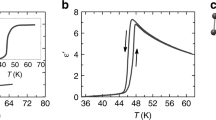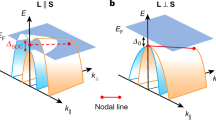Abstract
Magnetoresistive devices (based on, for example, magnetic multilayers1) exhibit large changes in electrical resistance in response to a magnetic field, which has led to dramatic improvements in the data density and reading speed of magnetic recording systems. Manganese oxides having a perovskite structure (the so-called manganites) can exhibit a magnetoresistive response that is many orders of magnitude larger than that found for other materials, and there is therefore hope that these compounds might similarly be exploited for recording applications2,3,4,5,6,7,8,9,10,11. Here we show that the switching of resistive states in the manganites can be achieved not only by a magnetic field, but also by an electric field. For manganites of the form Pr1−xCaxMnO3, we find that an electrical current (and by implication a static electric field) triggers the collapse of the low-temperature, electrically insulating charge-ordered state to a metallic ferromagnetic state. We suggest that such a phenomenon could be exploited to pattern conducting ferromagnetic domains within an insulating antiferromagnetic matrix, and so provide a route for fabricating micrometre- or nanometre-scale electromagnets.
This is a preview of subscription content, access via your institution
Access options
Subscribe to this journal
Receive 51 print issues and online access
$199.00 per year
only $3.90 per issue
Buy this article
- Purchase on Springer Link
- Instant access to full article PDF
Prices may be subject to local taxes which are calculated during checkout




Similar content being viewed by others
References
Baibich, M. N. et al. Giant magnetoresistance of (001)Fe/(001)Cr magnetic superlattices. Phys. Rev. Lett. 61, 2472–2475 (1988).
Kusters, R. M., Singleton, D. A., Mcgreevy, R. & Hayes, W. Magnetoresistance measurements on the magnetic semiconductor Nd0.5Pb0.5MnO3. Physica B 155, 362–365 (1989).
von Helmont, R., Wecker, J., Holzapfel, B., Schultz, M. & Samwer, K. Giant negative magnetoresistance in perovskite La2/3Ba1/3MnOxferrmomagnetic films. Phys. Rev. Lett. 71, 2331–2333 (1993).
Jin, S. et al. Thousandfold change in resistivity in magnetoresistive La-Ca-Mn-O films. Science 264, 413–415 (1994).
Tokura, Y. et al. Giant magnetotransport phenomena in filling-controlled Kondo lattice system: La1−xSrxMnO3. J. Phys. Soc. Jpn 63, 3931–3935 (1994).
Urushibara, A. et al. Insulator-metal transition and giant magnetoresistance in La1−xSrxMnO3. Phys. Rev. B 51, 11103–14109 (1995).
Tomioka, Y., Asamitsu, A., Moritomo, Y., Kuwahara, H. & Tokura, Y. Collapse of a charge-ordered state under a magnetic field in Pr1/2Sr1/2MnO3. Phys. Rev. Lett. 74, 5108–5111 (1995).
Tomioka, Y., Asamitsu, A., Moritomo, Y. & Tokura, Y. Anomalous magnetotransport properties of Pr1−xCaxMnO3. J. Phys. Soc. Jpn 64, 3626–3630 (1995).
Tomioka, Y., Asamitsu, A., Kuwahara, H., Moritomo, Y. & Tokura, Y. Magnetic-field-induced metal-insulator phenomena in Pr1−xCaxMnO3with controlled charge-ordering instability. Phys. Rev. B 53, R1689–R1692 (1995).
Kuwahara, H., Tomioka, Y., Asamitsu, A., Moritomo, Y. & Tokura, Y. Afirst-order phase transition induced by a magnetic field. Science 270, 961–963 (1995).
Kuwahara, H. et al. Striction-coupled magnetoresistance in perovskite-type manganese oxides. Science 272, 80–82 (1996).
Jonker, G. H. & Van Santen, J. H. Ferromagnetic compounds of manganese with perovskite structure. Physica 16, 337–349 (1950).
Zener, C. Interaction between the d-shells in the transition metals. II. Ferromagnetic compounds of manganese with perovskite structure. Phys. Rev. 82, 403–405 (1951).
Anderson, P. W. & Hasegawa, H. Considerations on double exchange. Phys. Rev. 100, 675–681 (1955).
de Gennes, P.-G. Effects of double exchange in magnetic crystals. Phys. Rev. 118, 141–154 (1960).
Jirak, Z., Krupicka, S., Simsa, Z., Dlouha, M. & Vratislav, Z. Neutron diffraction study of Pr1−xCaxMnO3perovskite. J. Magn. Magn. Mater. 53, 153–166 (1985).
Yoshizawa, H., Kawano, H., Tomioka, Y. & Tokura, Y. Neutron-diffraction study of the magnetic-field-induced metal-insulator transition in Pr0.7Ca0.3MnO3. Phys. Rev. B 52, R13145–R13148 (1995).
Acknowledgements
This work was performed at JRCAT under the joint research agreement between the NAIR and the ATP, and was supported by NEDO and by a Grant-In-Aid for Scientific Research from the Ministry of Education, Science, and Culture, Japan.
Author information
Authors and Affiliations
Corresponding author
Rights and permissions
About this article
Cite this article
Asamitsu, A., Tomioka, Y., Kuwahara, H. et al. Current switching of resistive states in magnetoresistive manganites. Nature 388, 50–52 (1997). https://doi.org/10.1038/40363
Received:
Accepted:
Issue Date:
DOI: https://doi.org/10.1038/40363
This article is cited by
-
Resistive random access memory: introduction to device mechanism, materials and application to neuromorphic computing
Discover Nano (2023)
-
Multi-field modulation of transport properties in critical state (La1-yPry)0.5Sr0.5MnO3 thin films
Applied Physics A (2022)
-
Transverse barrier formation by electrical triggering of a metal-to-insulator transition
Nature Communications (2021)
-
Characteristics of Resistive Switching of SRO/SrZrO3/Pt Stack Processed at Full Room Temperature
Electronic Materials Letters (2021)
-
Non-thermal resistive switching in Mott insulator nanowires
Nature Communications (2020)
Comments
By submitting a comment you agree to abide by our Terms and Community Guidelines. If you find something abusive or that does not comply with our terms or guidelines please flag it as inappropriate.



